
Review
Anno 117 review: reaching a flow state by building in ancient Rome
by Samuel Buchmann

In Jurassic World Evolution 3, I give dinosaurs a (new) home and breed deceased species thanks to the science of genetics. Is such a mission doomed to failure?
I find myself in a sandy area somewhere in America. My first own dinosaur park? Awesome! Good old Cabot Finch is also at my side in the third instalment and guides me through my tasks. I also have to take deliveries straight away, bring the new dinosaurs into their enclosure and create a natural environment for them. So far, so cosy. However, a nasty storm has just come up, which unfortunately destroys an enclosure. Naturally, the dinosaurs in the enclosure escape at the drop of a hat. So I have to stun them from a helicopter - which I control myself -, repair the enclosure and put the roawrs back in.

No wonder, there are already discussions between my three main characters Cabot Finch, Kira Chang from DIN (Dinosauroer Integration Network) and the critically minded mathematician Dr Ian Malcolm. You may recognise the latter from the Jurassic Park universe. I like him.
Even without instruction from these characters, their attitudes are quickly made clear. That's why Dr Malcolm is sceptical when the dinos break out so quickly. Finch reassures him: «See how quickly we got a situation like this under control? That means only good things». As in every Jurassic Park story, the Dr Malcolm in me knows: this can only go wrong.
For my review, I decided to focus on the campaign mode. This takes place after the events of «Jurassic World: A New Age». Other options include a challenge mode, sandbox mode and a workshop where you can download other players' creations.
I have to mention up front that I haven't played either of the two previous games and am diving into Jurassic World fresh, happy and naive.
The story begins in my first park in Egg Mountain in the USA. There are already enclosures and two dinosaur species here, which end up in my care. My tasks are of a different nature and are explained to me on an ongoing basis. I have already accepted one dinosaur delivery. When the next one arrives, I am immediately informed that some species get on well with each other. So I add them to the existing dinosaurs. Then I have to adapt the environment so that both species are happy. Plant suitable trees, provide enough sandy soil and so on.
In total, there are three overarching, relatively self-explanatory goals for the facility:
I can always choose between three sub-goals, which give me points for achieving these overall goals - and of course money. For example, a certain number of visitors, revenue per minute or building a better infrastructure in the park.
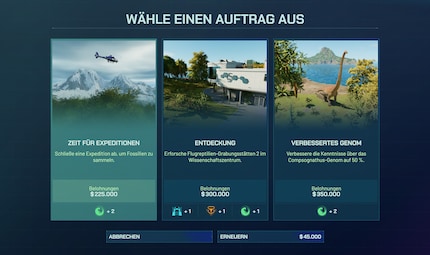
For an exciting park, you need cool dinosaurs, of course. In addition to the existing ones, I have the opportunity to have fossils collected and researched on expeditions. I can then synthesise them, create eggs and hatch dinosaurs. Dr Malcolm is not the only one who is concerned about this project. Artificially breeding dinosaurs and tampering with nature has never been a good thing in the Jurassic universe.
However, the latest incentive makes me quickly forget my negative thoughts: Babydinos! For the first time in the game series, I can hatch young animals from eggs. They are not quite as small as I thought they would be, but they are still very cute. A total of 80 different animals should be possible to make the park as popular as possible. Of course, I need males and females in the enclosure and a nest that matches the species.

This sounds simple if everything is available. But if there are no males of a dinosaur species in the world, I have to instigate my scientists to produce them synthetically. While the herbivores lead a cosy family life in the enclosure, I have great respect for the carnivores.
As soon as the power to the enclosure is cut off, the blood-hungry animals want to escape or attack my poor rangers if there isn't enough food. To prevent this from happening, I have to send my rangers out on patrol and hire maintenance teams. I distribute the teams well around the site and assign them areas. This doesn't work 100 per cent reliably, but that would be too boring. Instead, I can regularly check all the buildings to see if maintenance is necessary to prevent the worst from happening. While I tend to take it easy in other Management games, I always have a queasy feeling here. After all, angry dinosaurs could attack my visitors at any time. That keeps me on my toes in a positive sense.
This constant tension between breeding/care and the threat of chaos makes «Jurassic World Evolution 3» a real survival management game.
It's not just the dinos that need enough food, attention and a nice environment, my visitors also want their needs met. Initially, they took a back seat and I was able to focus on the Roawrs. But now they want a fancy viewing platform to admire them.
Food, drink and souvenirs must also be provided. I can only indirectly determine what is sold, as the visitors are more or less satisfied depending on the selection. Of course, they are happier if I serve them burgers and fries instead of healthy bento boxes. Whether my selection is well received is shown by a graphic in the building information using smileys, and of course the turnover. One thing I miss, which I used to really like in «Roller Coaster Tycoon», for example, is additional information about the individual visitors. If I clicked on them, I could see what they liked and didn't like about the park. That's missing here.

In the beginning, my options are rather limited. The small hotels and restaurants fill up quickly and not all architecture is popular. European houses are more popular in European parks, for example. I have to research larger buildings first. I also use my scientists here, as I do for the expeditions. Scientists generally help with the development of everything. Whether in genetic research, new medicine or even park attractions and buildings. But they also cost enough and are quickly stressed. That's why they have to be deployed carefully and I regularly let them sleep to recover.
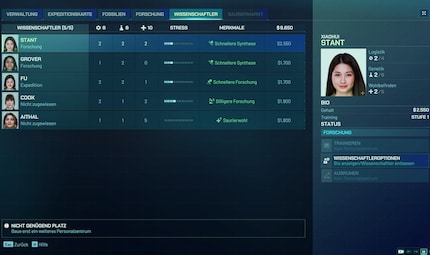
I enjoy recruiting different scientists for my goals. Although the research into new restaurants by geneticists and the like makes no sense thematically, this mechanic serves as a central resource and time management system that forces me to prioritise wisely.
At first, it seems as if I can determine my own focus and concentrate on discovering as many dinosaur species as possible. However, I need enough money and other resources to do this. I quickly realise that everything is interdependent and needs to be done in the right order.
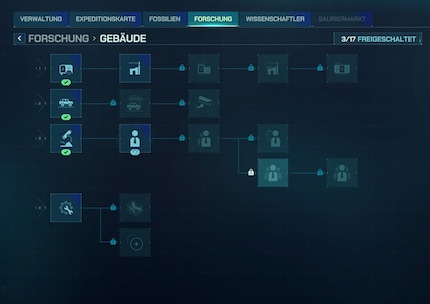
In order for me to have different focuses despite the fairly clear structure of the game, «Jurassic World Evolution 3» relies on an exciting mechanism: new parks in different parts of the world come under my care on an ongoing basis. For example, I can help design a facility with a research station in Hawaii or help a run-down park in Nevada get back on its feet. Pterosaurs have broken out there and the existing buildings need a thorough renovation. After the introduction, I can decide for myself what I want to focus on. Once I've had enough of the pterosaurs in Las Vegas, I'll get back to the somewhat busier park in Egg Mountain. My ADHD heart leaps for joy!
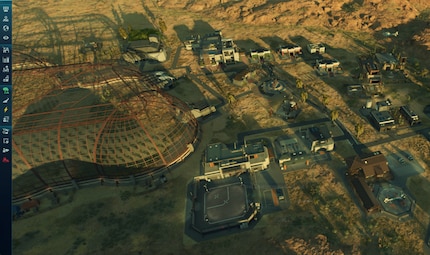
Expeditions are an item on the agenda that has already been mentioned. I also need my valuable scientists for this. I send them to excavation sites all over the world. Of course, I can't go with them, but when they return, I get fossils and valuable artefacts that I can sell.

The fossils are for researching genes so that I can breed dinosaurs from them. The more research I do, the more excavation sites are unlocked. My big goal is of course the main attraction of the whole of Jurassic World: to find and breed the Tyrannosaurus. It all takes a lot of time. The scientists need around three to four minutes of in-game time to analyse each group of fossils. Once I have enough gene data, I can analyse and breed them in my breeding sites and display them as an attraction in the enclosures I have built.
Every time an animal hatches, whether artificially or through the mating of two dinosaurs, I'm as happy as a little child. To make the most of the moment, I drive myself into the enclosure in a ranger car and take some nice photos. With pterosaurs, however, I have to use a drone as I can't get into the enclosure with the cars. The reward is great: I get a generous remuneration for good photos.
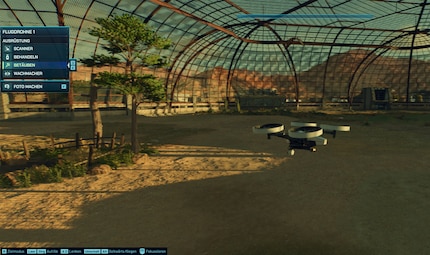
In this way, I can see the very successful graphics from a different angle. It is detailed, realistic and yet not overdone. Otherwise, I would probably have had to worry that my computer would hang up. As it is, the game is a well-rounded affair: it runs reliably and I can enjoy the view from the Jurassic balloon or take family photos of my favourite dinosaurs. After a sandstorm, however, I realise that although time passes, there are no fixed times. In some places in my campaign, it doesn't even get dark yet, even if I fast-forward the time.
After a few hours of playing, I still can't get enough of the view of the dinosaur world. Whether it's hatching babies or furious apha battles, I like to simply watch the dinos between my tasks.
I can't wait to see what other tasks and catastrophes await me and whether the mission to bring the dinosaurs safely back to our world will finally succeed this time. But the next storm is already waiting ...
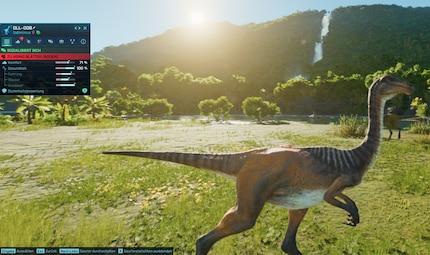
The game was provided to me by Frontier. It will be available from 21 October for PC and Xbox
"Jurassic World Evolution 3" offers a captivating mix of park Management and the nerve-wracking handling of prehistoric animals. The introduction of baby dinosaurs as a highlight and the diverse tasks in different parks provide variety and always keep me on my toes as a player.
While the game principle of research, breeding and infrastructure management works well and impresses with its successful graphics, I would like to see more personal information about the visitors and a less rigid dependency on progress.
Overall, it's an entertaining building game for fans of the genre, where the next eruption or storm always provides an exciting surprise.
Pro
Contra
In my world, Super Mario chases Stormtroopers with a unicorn and Harley Quinn mixes cocktails for Eddie and Peter at the beach bar. Wherever I can live out my creativity, my fingers tingle. Or maybe it's because nothing flows through my veins but chocolate, glitter and coffee.
Which films, shows, books, games or board games are genuinely great? Recommendations from our personal experience.
Show all